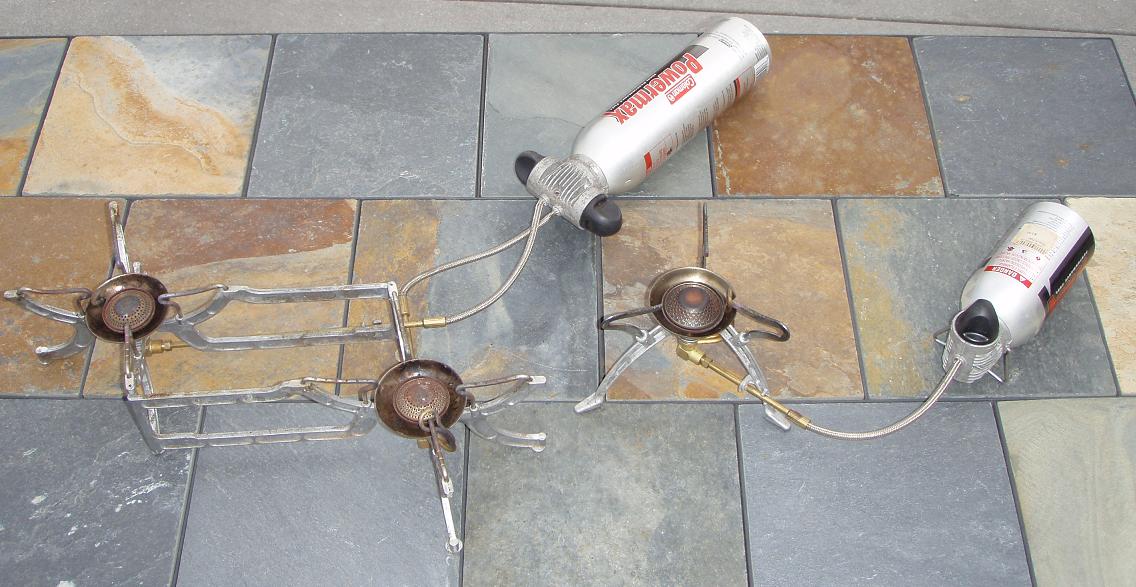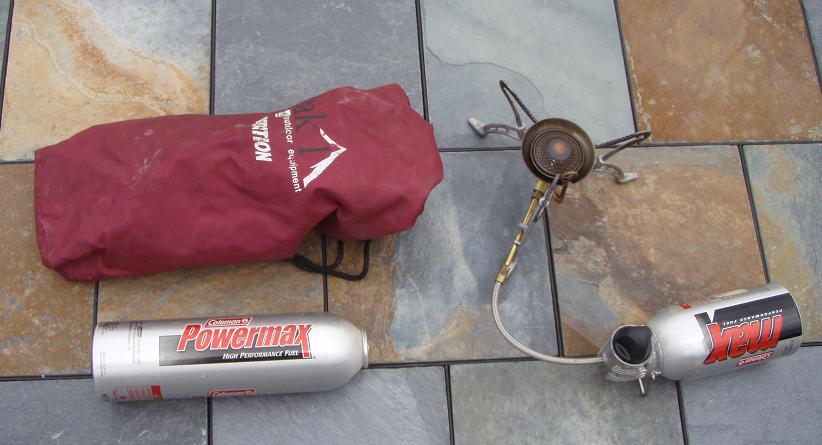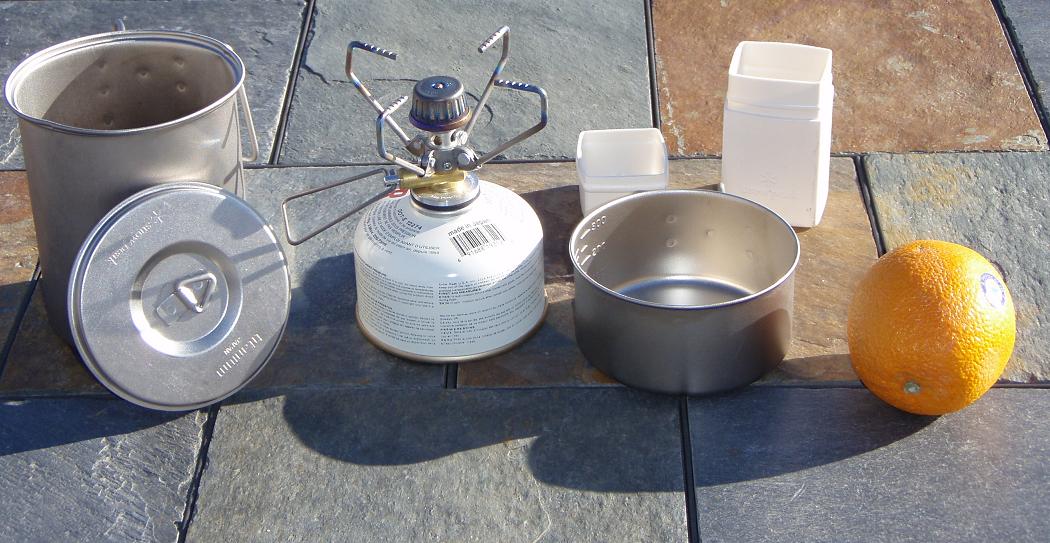|
| The Double and Single Burner X Stoves |

|
Coleman Xtreme and Xpedition
(Single burner Xtreme is 10.8 ounces)
(Double burner Xpedition is 25.3 ounces)
The Coleman Xtreme and Xpedition are both canister stoves which run off of a proprietary Coleman butane canister. The thing
that makes these stoves different from most other butane canister stoves is that they have better cold weather performance
than typical butane or butane/propane canister stoves.
This is because these Coleman stoves suck liquid butane out of the canisters, and this liquid butane is heated to a gaseous
state in the stove, by means of a feeder tube which runs through the flame. I'm sure that there is something else going on
that I've missed (it can't be quite that simple or someone would have thought of it long ago), but the bottom line is that
these stoves will function at temperatures much colder than that of ordinary butane/propane stoves.
The problem with ordinary butane stoves is that when the temperatures drop to around freezing, the butane stays trapped
in a liquid state rather than a gas state, and most stoves are only built to accommodate butane gas. This problem is alleviated
at higher altitudes (butane stays gaseous at colder temperatures, the higher you are), but in general, traditional canister
stoves don't work well in cold weather. There are a number of companies who have now approached this problem from
a slightly different angle, by simply inverting a normal butane/propane canister so that it feeds from the bottom rather than
the top. This solution works on the same liquid feed principle. To date, I have not used any of these inverted
canister stoves, so I can't comment on how they compare in performance to the Coleman proprietary canister stoves.
In the real world, I have been able to cook with the Coleman "X" stoves in temperatures well below freezing. The lowest
I've used them is in temperatures of about 5 to 10 degrees F. and I didn't have any problems with them. This is far colder
than I could have used traditional butane fuel without taking measures to warm the canisters prior to and during use.
The stoves are well put together, and have good simmer control. The Xtreme is unremarkable, and pretty much looks like
any other collapsible canister stove. Its three folding legs provide adequate stove and pot stability. The Xpedition, however,
is something completely different. It features two connected burners, with the flame for each separately adjustable. The result
is that you have the cooking ability of one of those big, heavy, car-camping Coleman two burner stoves in a compact lightweight
package suitable for backpacking. For one or two people, the two burner Xpedition is overkill, but for groups of 4 or more,
it allows you to cook in ways you can't using a single burner.
I have a lightweight aluminum rectangular skillet which I use in connection with the Xpedition, which allows me to fry
up large amounts of eggs, bacon and pancakes at one time. It really speeds things up when you are cooking for large groups.
For long backpacking trips with my scout troop, the Xpedition really saves us time over using several single burner stoves,
as it allowed us to cook in large batches. Anyone who has tried to cook pancakes in a small frying pan on a single burner
will appreciate the possibilities of the Xpedition.
I have not done any scientific tests, but it does seem that the fuel consumption of these stoves is a little high
compared with traditional butane or white gas. I seem to go through more fuel than I expect when using these stoves, especially
when they are on full burn. Overall, however, I don't have much negative to say about either the Xpedition or the Xtreme.
They offer the convenience of a canister stove, with much improved cold weather performance.

|
| The two burner Xpedition allows you to use a big griddle for big meals |

|
| The 2 burner model packs down quite compactly |
Snow Peak Ultralight Giga Stove
Stove is 2.6 ounces
Stove and "Mini Solo" 0.8 liter titanium pot are 6.4 ounces
Stove, pot, and small fuel canister are 12.9 ounces
This is my "light duty" stove. It's the stove I take with me when I am going on a
day trip and want to be able to brew up some hot cider or hot ramen for lunch. I use this stove almost exclusively for
day hikes and ski trips. I also use it almost exclusively with the titanium pot from the Snowpeak "mini Solo" cook
kit. The pot holds 0.8 liters, and is is sized to fit the Giga stove and a small fuel canister inside.
The stove, fuel canister, pot, and lid together weigh a hair under 13 ounces and is very compact.
This is a great "lunch" stove, because it is light, small, and fires up without any hassle.
I suppose that it would work for general camping use as well, but I prefer other stoves for those purposes, at least in part
because it's a bit touchy to use a windscreen with this stove without running the risk of overheating the canister. The
Giga has decent heat output, and pairs well with the relatively small (0.8 liter) Mini Solo pot, heating water up easily.
I've even used it for modest snow melting tasks, but it isn't really designed for this.
For me, the Giga is a niche product, providing me and my friends or family with a hot drink or
meal while on day trips.

|
| Giga Stove and Mini Solo cook set. |

|
| The Giga stove and a fuel canister nests inside the Mini Solo cookware |
|

